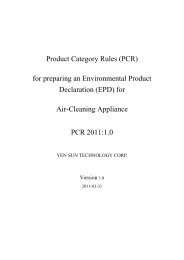Product Category Rules (PCR) - PCR Library
Product Category Rules (PCR) - PCR Library
Product Category Rules (PCR) - PCR Library
Create successful ePaper yourself
Turn your PDF publications into a flip-book with our unique Google optimized e-Paper software.
R4 (by dividing amount collected by total amount shipped), and follow the formulas below to obtain the ratios of<br />
the processes other than voluntary collection.<br />
R1 = (1 - R4) x 22%<br />
R2 = (1 - R1 - R4) x 16% / (16% + 62%) = (78% - R4) x 20%<br />
R3 = (1 - R1 - R4) x 62% / (16% + 62%) = (78% - R4) x 80%<br />
H.1.2 Waste-derived GHG emissions generated from incineration<br />
The factor of GHG emissions associated with incineration process is GHG emissions generated from combustion<br />
of the fuel input to incinerate the waste. Therefore, it is necessary to calculate the GHG emissions derived from<br />
carbon contained in the waste separately, and include it additionally.<br />
Assuming that no greenhouse gas other than CO2 is generated from combustion of resin, CO2 emissions<br />
calculated on the basis of the carbon contained in the resin shall be deemed as the GHG emissions.<br />
The followings are the examples of carbon content ratios in the resin and the method of calculation.<br />
a) Examples of carbon content ratios<br />
PP: 85.7%, PE: 85.7%, PS: 92.3%, PVC: 38.4%, PET: 62.5%<br />
Note that, if the type of resin is unknown, the content ratio of PS, 92.3%, shall be used to avoid underestimation.<br />
b) Example of calculation method<br />
When 10g of PP resin is incinerated;<br />
Waste-derived GHG emissions generated from incineration: 10g x 85.7% x 44 / 12 = 31.4g - CO2e<br />
H.2 Scenario for designated PET bottles (scenario for individual field)<br />
Used designated<br />
PET bottles<br />
H.2.1 Method of calculating ratio between disposal and recycling<br />
Based on the statistic data mentioned below, ratio between disposal and recycling of used designated PET bottles<br />
was calculated as follows.<br />
a) Ratio of recycling (collection ratio of resource waste): R1<br />
The value obtained by dividing the amount of designated PET bottles collected, W1 (amount of sorted collection<br />
in municipalities added by amount of collected business-related bottles), in 2008 by the total amount of<br />
designated PET bottles sold, W0, in the same year; according to the data announced by the Council for PET<br />
Bottle Recycling:<br />
W1 W0 R1<br />
445 thousand tons / 571 thousand tons = 78%<br />
b) Ratio of landfill: R2, and ratio of incineration: R3<br />
The ratio of the designated PET bottles which are not recycled shall be distributed as follows by applying the<br />
ratio of landfill and ratio of incineration obtained following “H.1.1 Method of calculating ratio between disposal/<br />
recycling” in “H.1 Scenario common to all plastic containers and packaging”.<br />
R2 = (1 - 78%) x 16% / (16% + 62%) = 5%<br />
R3 = (1 - 78%) x 62% / (16% + 62%) = 17%<br />
H.2.2 Waste-derived GHG emissions generated from incineration<br />
Calculate and include according to the scenario specified in “H.1.2 Waste-derived GHG emissions generated from<br />
incineration”.<br />
Waste<br />
Resource waste collection<br />
(recycling)<br />
R1=78%<br />
Trans-<br />
port<br />
A<br />
Incineration<br />
R3=17%<br />
Landfill<br />
R2=5%<br />
Compac-<br />
ting<br />
-27-<br />
* Indirect effect shall not be included in calculation results,<br />
but such information may be included additionally in<br />
labeling in the manner separated from the main<br />
information.<br />
Transport<br />
Material recycling<br />
Chemical recycling















